This post was co-authored by the Forecasting Research Institute and Bridget Williams. Thanks to Josh Rosenberg for managing this work, Zachary Jacobs and Molly Hickman for the underlying data analysis, Kayla Gamin for fact-checking and copy-editing, and the whole FRI XPT team for all their work on this project.
Summary
- Previous forum posts explored XPT results relevant to specific risk areas: AI, nuclear, and biorisk. Rather than focus on a specific risk area, this post summarizes results from some cross-cutting questions asked in the XPT. This includes questions on the expected duration and size of humanity, attitudes of Americans, and some other questions that might be considered indicators of global progress.
- XPT superforecasters predicted there would be 500 billion people who would ever be born from 2023 onwards. XPT experts predicted 135 billion. The median prediction from a survey of over 400 college graduates was far lower at 9 billion.
- The median college graduate predicted that human extinction would occur in 2500, an estimate far lower than that of XPT experts (6261), and superforecasters (15,000).
- College graduates were also least optimistic about self-reported happiness in America, predicting that 80% of adult Americans would report feeling "very" or "fairly" happy in 2050 and 2100, compared to superforecasters’ median prediction of 87%, and XPT experts’ median prediction of 85%.
- As the survey of college graduates did not collect rationales, it’s unclear why this group gave such pessimistic responses to some questions.
- When asked to estimate the earliest date that at least 90% of Americans would say they wish they had been born in a previous generation, the median XPT forecaster predicted this occurring by 2500. The predictions were similar between superforecasters (median forecast of 2527.5) and experts (2500).
- Superforecasters and experts had similar estimates for the probability of widespread global crop failure by 2100, with the median estimate for both groups roughly 6%.
- Experts were more optimistic that humanity would create an extra-terrestrial space colony by 2100 (median estimate of 12.5%, compared to superforecaster median of 3%), and that fewer people would live in autocracies by 2100 (expert median of 55%, compared to superforecaster median of 65.5%). Both groups predicted that the proportion of people living in autocracies would decrease from the current estimate of 70.55%.
- Although there were many areas of disagreement, a common theme amongst discussions of these questions was uncertainty about the impacts of AI, particularly the degree of extinction risk it poses, but also the likelihood of it enabling progress, and whether it would strengthen or weaken autocracies.
The XPT
From June through October 2022, 169 forecasters, including 89 superforecasters and 80 experts participated in the Forecasting Research Institute’s (FRI) Existential Risk Persuasion Tournament (XPT). Participants developed forecasts on questions related to existential and catastrophic risk, as well as other questions on humanity’s future. A public survey of college graduates (largely from the UK and US) was also conducted alongside the XPT, which included a subset of XPT questions.
Participants in the XPT made individual forecasts and were encouraged to develop written rationales for their forecasts. Participants were later grouped into teams to discuss their forecasts and develop a team forecast. Teams were asked to combine their rationales into a team wiki describing the strongest argument for the team’s median forecast, along with rationales for lower- and higher-end forecasts that they considered plausible, and describing key areas of disagreement and uncertainty.
Further detail on the tournament and the overall results are available in this report. Previous forum posts have explored results relevant to specific risk areas: AI, nuclear, and biorisk. Rather than focus on a specific risk area, this post summarizes results from some cross-cutting questions asked in the XPT. This includes questions on the expected duration and size of humanity, attitudes of Americans, and some questions that might be considered indicators of global progress.
The arguments discussed below are taken from the rationales in team wikis, but should not be taken to present an exhaustive review of forecasters’ opinions, or as a consensus view of XPT participants.
Duration of humanity and size of human population
Forecasters were asked to predict the year of human[1] extinction (duration), and the number of humans who would be born from 2023 onwards (size).[2] These questions were also asked in our survey of college graduates.
Superforecasters were the most optimistic about the size of humanity’s future. Their median prediction of the year of human extinction was the year 15,000 [90% CI: 2250, 1,640,000], and they predicted that there would be 500 billion future humans [11.7 billion, 100 trillion]]. XPT experts predicted 6261 as the median year of extinction [2080, 4,750,000], and 135 billion future humans [6.19 billion, 170 trillion]. Respondents to the public survey were notably more pessimistic than XPT participants: the median public prediction put the year of human extinction at 2500, and the number of future humans at 9 billion. This prediction of the number of future humans seems overly pessimistic, even assuming a year of human extinction of 2500. Modeling by Spears et al. suggests that a total fertility rate (TFR) of 1.2—which is much lower than the World Bank’s current estimate of a global TFR of 2.3—would lead to at least 10 billion further people born before 2200 (although it’s worth noting that this scenario projects only 30 billion further people being born). The superforecaster and expert median estimates for the number of people who will be born are roughly 3–4x lower than a scenario where the current global birth rate—of roughly 130 million people born each year—continues until the median predicted year of extinction.
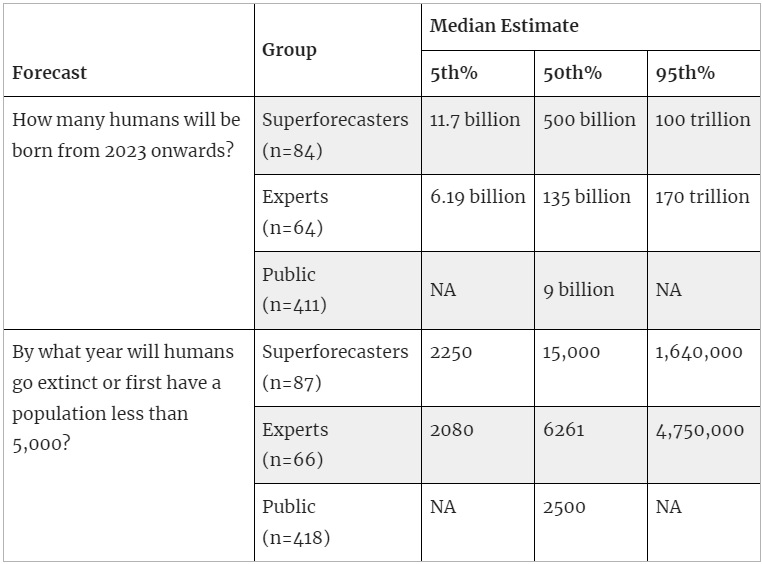
There were several approaches used by XPT forecasters to predict the year of human extinction. These included:
- Starting with a base rate for species extinction and adjusting for factors that would suggest human extinction risk deviates from this base rate. Several base rates were suggested, including the average lifespan of a mammalian species and the average lifespan of a hominid species. Adjustment was usually based on estimated impact of technology.
- Combining estimates of extinction risk in different periods to develop a forecast (e.g. for the next century and then beyond).
- Combining probability estimates of humanity reaching different milestones (e.g. interstellar travel).
- Using the Doomsday Argument, a statistical argument for the expected total population of humans using the number of humans born to date, and combining this with birth rates to come to an expected year of extinction.
Most forecasters developed their estimate for the number of future humans by combining their expected duration of humanity’s future with estimates of the future birth rate. Others used the Doomsday Argument.
The areas of disagreement were the degree of existential risk posed by technology (especially AI), the plausibility of the time-of-perils hypothesis, the likelihood of interstellar travel, and whether technological change would see post-human beings emerge.
The public survey did not gather rationales for predictions, so it is unclear what assumptions are driving the low estimates from respondents.
Attitudes in America
Several XPT questions asked about the attitudes of Americans. This included self-reported happiness, questions on when most people would choose not to have children due to concerns about the future, and questions on when 90% of people would say they wished they had been born in a previous generation.
Happiness in the USA
The XPT asked about the percentage of Americans who will report being generally “very” or “fairly” happy in a nationally representative poll.[3] Forecasters were provided with data from a Gallup poll that had asked this question in the past. This showed that in 2019 86% of respondents reported being generally “very” or “fairly” happy. This had dropped from 91% in 2008, and was the lowest percentage recorded by Gallup in the 71 years it has been conducting this poll.
Of the three groups, superforecasters were the most optimistic, expecting 87% of Americans in 2100 to report feeling happy. The median XPT expert prediction for 2100 was 85%, and the median college graduate prediction was 80%. For all groups, the median predictions were consistent between 2050 and 2100.
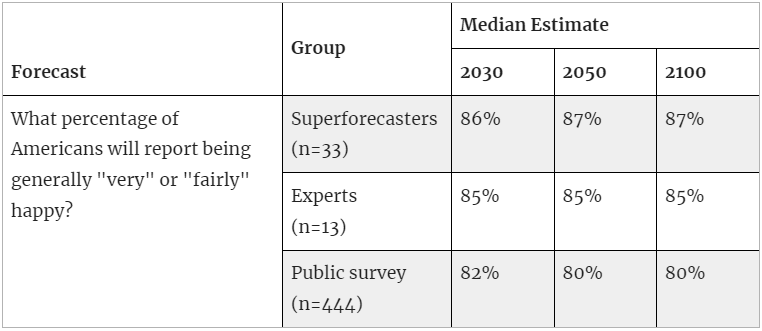
Team rationales suggested that forecasters disagreed on whether we should expect living standards, or objective metrics like GDP, to improve or decline in the future. However, some put less weight on these considerations, arguing that self-reported happiness doesn’t track material conditions and is generally stable. Relatedly, participants disagreed on whether the drop between 2008 and 2019 should be seen as indication of a trend, or just random variation from a stable baseline.
Children and future worries
Forecasters were asked when at least 50% of US adults will first say they expect to have no children, or no more children, due to worry about the long-term future.[4] Experts predicted this would occur in 2400 [2039, 1e210], 300 years sooner than the superforecaster median prediction of 2700 [2070, 10,000]. (This question was not included as part of the survey of college graduates.) Although team rationales mentioned that many forecasters thought that this would never occur, the median 95th% estimate for superforecasters was 10,000, suggesting that at least most superforecasters thought this would occur eventually.
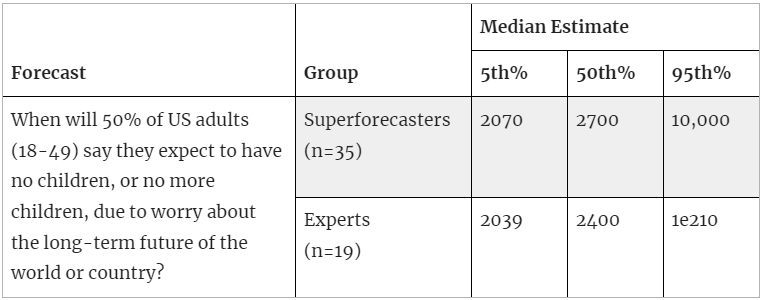
XPT participants used different estimates as the baseline estimate of the current proportion of people who plan not to have children due to future worries. The additional details of the question included results of two surveys: a 2021 Pew Research survey which was reported as showing that around 2% of US adults (18-49) reported not planning to have children due to concerns about the future, and a 2020 Morning Consult survey, that suggested that 14% of adults aged 18-45 without children cited concern about climate change as a major reason they didn’t have children. Some forecasters also referred to a 2021 survey that reported 39.1% of a sample of children and young people (from 10 different countries) reported being hesitant to have children because of concerns around climate change.
Forecasters disagreed on whether it would ever be the case that 50% of people report not planning on having children due to concerns about the future. Those who thought this was unlikely to ever happen referred to humans generally having a strong biological desire to procreate, and this occurring even during times of bad living conditions. Forecasters who disagreed, and thought that this milestone would indeed be reached, suggested that current trends might continue, or that a major catastrophe would make life so miserable that people would not want to procreate.
Generational attitudes
Superforecasters and experts made similar median predictions (2527.5 and 2500, respectively) of the year when 90% of Americans will say they wish they had been born in a previous generation.[5] As with the previous question, there was disagreement on whether this would ever occur, but the 95th% superforecaster estimate of 9500 suggests that the majority of this group believes it will occur eventually.

Forecasters who thought this was unlikely to occur noted that 90% is a very high bar, and suggested this being met would require “continuous extreme deprivation and/or calamity, or complete social stagnation” of a kind that has never existed in the past several centuries. Many also argued that humans are biased towards optimism and would have a natural preference for their own time.
Those that suggested lower dates for this question resolving cited surveys of dissatisfaction, including a 2017 survey that suggested that a third of Millennial Britons wished they had grown up in a previous era, and several reasons why the world may get worse in the future (e.g., economic stagnation, climate change, other catastrophes).
Other indicators of global progress
Several other XPT questions asked about aspects of humanity’s future, but were not clearly linked to other risk areas (AI, biorisk, nuclear, and climate change). These included the proportion of the world population living under an autocratic regime, the likelihood of widespread crop failure, and the likelihood of a space colony.
Population living under autocracy
XPT forecasters were asked to predict the proportion of the world population that would be living under an autocratic regime.[6] The details of this question referred to data presented by Our World in Data, that suggest that 70.55% of the global population was living under an autocratic regime in 2022.[7] The median estimates from XPT superforecasters and experts, and the survey of college graduates, suggested that this proportion would decrease. XPT experts were the most optimistic, with a median estimate of 55% in both 2050 and 2100. College graduates predicted 60% in both 2050 and 2100. Superforecasters were the least optimistic. They also predicted a decline, but a more modest one than the other groups, with a median of 65.5% by 2100.
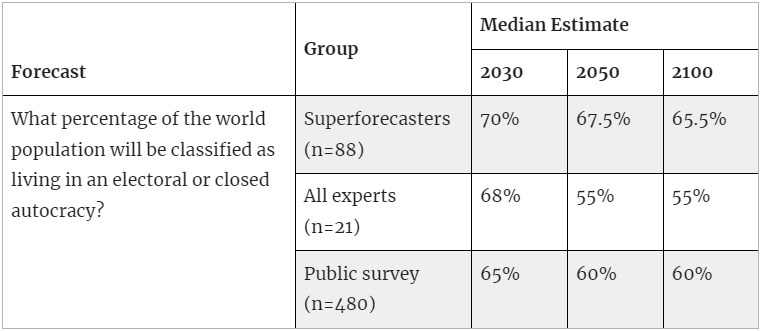
XPT forecasters disagreed on whether the recent reversal of the long-term trend toward democracy means the long-term trend is over, or whether it’s just a temporary dip. Those who were more optimistic cited the longer-term trend towards democracy, the global dominance of the democratic West, and the potential for improved technology—particularly technology enabling communication—to promote democracy. Those who were more pessimistic suggested that there is evidence that several populous countries are becoming increasingly autocratic (including India, Pakistan, Egypt, Brazil, Russia, and Nigeria), and that more autocratic countries will have higher birth rates. An important point of disagreement was whether AI developments would help or hinder democracy, with forecasters presenting arguments for this going either way.
Crop failures
Superforecasters and experts made similar predictions of the probability that the total worldwide production of primary crops falls by at least 70% in a three-year period; both groups predicted around 2-3% by 2050 and around 6% by 2100.[8]
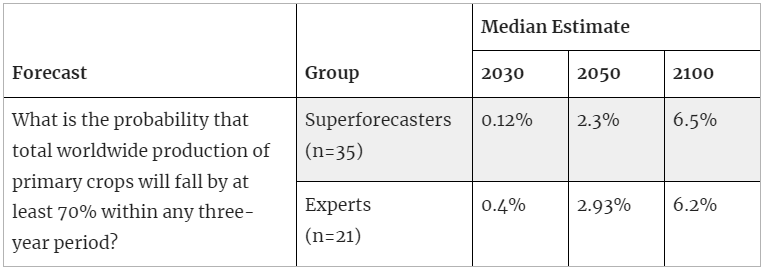
There was widespread though not unanimous agreement that nuclear war was the most likely cause of this question resolving positively, with several teams referencing a 2022 study by Xia et al. on agricultural effects of nuclear war. However, some forecasters suggested that other catastrophes, including climate change, AI, and biological events, may also cause this level of crop failure. Major disagreements on this question focused on the amount of damage likely to be caused by nuclear war and the likely effects of climate change.
Space colony
Compared to superforecasters, experts in the XPT were more optimistic about a life-sustaining extraterrestrial space colony becoming established, with a median probability of 12.5% of this occurring by 2100, compared to a median superforecaster prediction of 3%.[9]
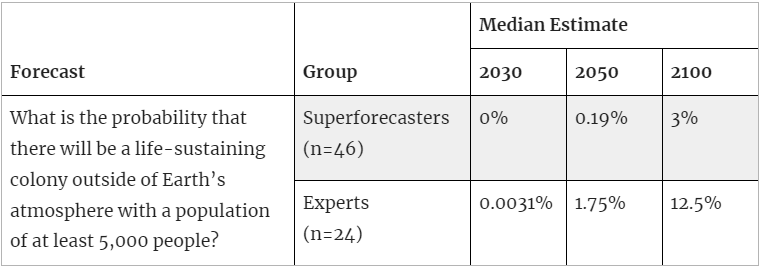
Forecasters discussed whether humanity would be motivated to create an extra-terrestrial colony and whether it would be feasible to do so. On motivation, some forecasters suggested that there aren’t political or economic incentives to create such a colony. However others suggested that the desires of billionaires may be sufficient for this to occur. Others also suggested that economic incentives may become apparent in the future. On feasibility, some referred to previous difficulties in establishing colonies in inhospitable places (e.g., Antarctica), but more optimistic forecasters pointed to the potential for rapid technological advancement to overcome challenges.
Conclusion
The questions discussed in this post involve a high degree of uncertainty. Amongst XPT participants, and respondents to the public survey, there was substantial variation in individual forecasts on these questions. However, there are a few interesting patterns in these results. Notably, the college graduates we surveyed were generally more pessimistic about humanity’s future than XPT forecasters. This was most obvious in the forecasts on the number of humans who will be born from 2023 onward and the year of human extinction. Unfortunately, we did not collect data on rationales for these forecasts, so the causes of this pessimism are unclear.
Compared to superforecasters, XPT experts were generally more pessimistic about humanity’s future, predicting lower numbers of future human lives, an earlier date of human extinction, lower reported happiness amongst Americans, an earlier date of when most Americans would wish they had been born in an earlier generation, and an earlier date for when most Americans would choose not to have children due to concerns about the future. One area where experts were more optimistic was in the proportion of people living under an autocratic regime.
The team rationales showed the variety of considerations that XPT forecasters used to generate forecasts and there was substantial disagreement on many topics. One prominent area of disagreement was about the impacts of AI, particularly the degree of extinction risk it poses, but also the likelihood of AI enabling progress, and whether it would promote or suppress autocracy.
- ^
For these questions, “humans” were defined as biological creatures who (A) can be traced back genealogically, via a chain of live births, to 2022 humans OR (B) could mate with 2022 humans and produce viable offspring OR (C) would be identified as Homo by at least 50% of a hypothetical panel of 100 randomly selected professors of biology from 2022, sampled from major universities. This definition of humans was inspired by this Metaculus question.
- ^
- ^
- ^
- ^
- ^
- ^
This estimate comes from the 2022 Democracy Report published by V-Dem.
- ^
- ^

This post wasn't clear about how the college students were asked about extinction, but here's a hypothesis: public predictions for "the year of human extinction at 2500" and "the number of future humans at 9 billion" are a result of normies hearing a question that mentions "extinction", imagining an extinction scenario or three, guessing a year and simply giving that year as their answer (without having made any attempt to mentally create a probability distribution).
I actually visited this page to learn about how the "persuasion" part of the tournament panned out, though, and I see nothing about that topic here. Guess I'll check the post on AI next...